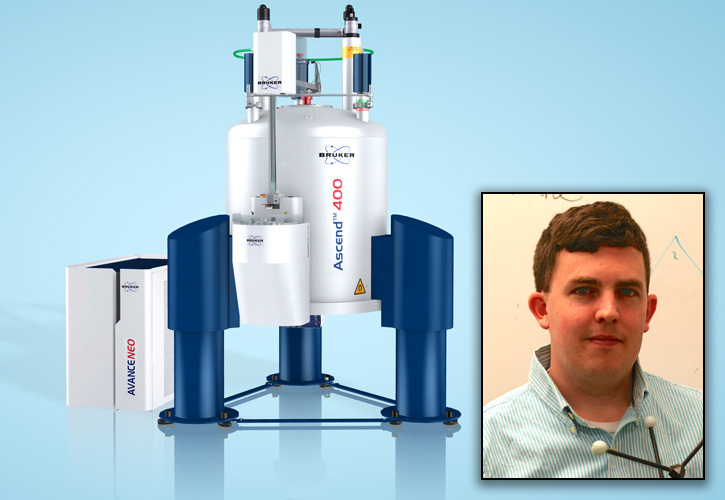College of Arts and Sciences Newsroom

National Science Foundation, Ohio Department of Higher Education Ohio Action Fund award UD chemists $290K for nuclear magnetic resonance spectrometer
By Dave Larsen
The National Science Foundation awarded University of Dayton chemists Jeremy Erb and Vladimir Benin $240,379 and the Ohio Department of Higher Education Ohio Action Fund provided an additional $50,233 for the purchase of a Bruker 400 MHz nuclear magnetic resonance spectrometer to support faculty research and student research training in chemistry and the biological sciences.
The National Science Foundation (NSF) award is supported by the agency’s Major Research Instrumentation (MRI) and Chemistry Research Instrumentation programs. It represents Erb’s first federal sponsored research grant and the first NSF MRI award for the College of Arts and Sciences.
Nuclear magnetic resonance (NMR) spectroscopy allows scientists to determine the chemical structure of a compound by bombarding molecules with radio waves while under the influence of a magnetic field. The new instrument will replace the Department of Chemistry’s outdated model, and provide state-of-the-art technology to enhance faculty research capabilities and expand student engagement in research.
“This may be the most important instrument in any given chemistry department, because so many faculty and students use it,” said Erb, associate professor of chemistry and principal investigator on the grant. “It is an indispensable tool in multiple fields of chemistry and also can be used quite heavily in other disciplines, like biology.”
He said some 2,500 undergraduate chemistry majors will use the instrument during the next 10 years, along with faculty and graduate students from the chemistry and biology departments. In addition, the instrument will be used to analyze compounds for students at Sinclair Community College in Dayton and Central State University, a public historically black institution in Wilberforce, Ohio.
Erb uses an NMR spectrometer heavily in his organic synthesis research, which focuses on developing new methods to build organophosphorus molecules.
“This instrument will have greater sensitivity and greater ease to detect different atom types,” he said. “What that will mean is I can run experiments faster and my data will look better, and I can probably get more information out of the data, because it will be clearer to examine and analyze.”
The new spectrometer will be equipped with an automation system to allow faculty and students to run multiple samples at any time of day or night, without someone monitoring the instrument. The resulting data will be loaded onto a network drive so users will be able to access their data remotely.
Previously, a faculty or student researcher would have to sit in front of the instrument, insert their compound, run the experiment and then collect their sample. The next person in line would wait their turn and then repeat the same 10- to 15-minute process.
The autosampler will allow all 250 undergraduate students enrolled in sophomore organic chemistry courses to run samples during lab classes. There are smaller versions of the NMR in the students’ lab space, but their capabilities are significantly reduced compared to the large, research-grade instrument.
“Students will be able to do more and they will be able to get better-looking data that is more closely aligned with actual research data,” Erb said. “It is moving closer to what they would actually experience in a research setting.”
In 2018, 64% of chemistry majors went on to pursue graduate school or professional programs. In the past five years, 44% of chemistry degrees were conferred to women.
The NMR spectrometer also will encourage research collaborations across academic disciplines. For example, biology doctoral student Elizabeth Evans will use the instrument to study cell membrane composition in Cope’s gray tree frogs, which can tolerate their bodies being frozen and survive.
“Part of that phenomenon has to do with how cells behave,” said Carissa Krane, professor of biology and Evans’ doctoral adviser. “Jeremy, as a chemist, was very willing to collaborate with us, using the NMR to start to think about ways to characterize the membranes of cells and how they behave and are able to recover.”
In April, Krane and Erb were recognized as 2020 honorees of the University’s STEM Catalyst grant program for their proposal, Frozen Alive: How the Biochemistry and Biophysics of Cellular Membranes Enhance Freeze Tolerance. However, grants were not issued for this funding cycle because of the COVID-19 pandemic. The pair also submitted an NSF grant proposal related to their transdisciplinary work.
“I’m not a chemist and Jeremy’s not a biologist, but together we are able to ask questions about a biological system, using this instrument,” Krane said. “It opens up a whole new avenue of addressing questions that I wouldn’t be able to do with the things in my lab. From the scientific perspective, it brought two of us together to address a question in a new and different way that we wouldn’t have been able to address alone.”
The spectrometer is expected to be in full operation by the fall 2021 semester, after delivery, installation and training for Erb and Benin, professor of chemistry and co-principal investigator on the grant.
For more information, visit the Department of Chemistry website.
Spectrometer image courtesy of Bruker BioSpin Corporation.
